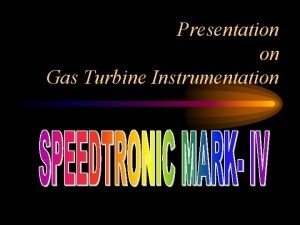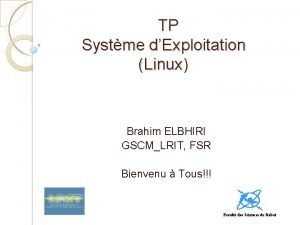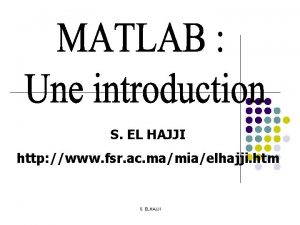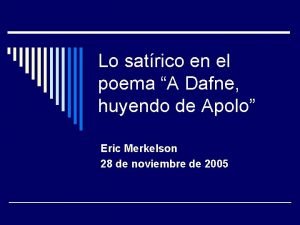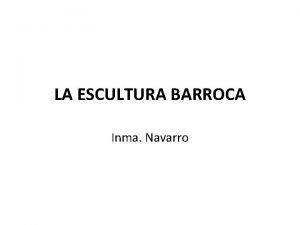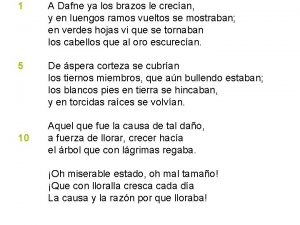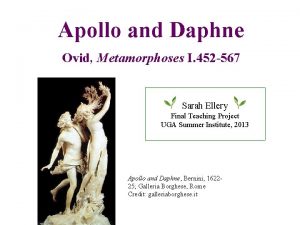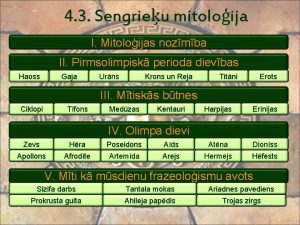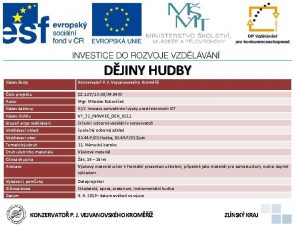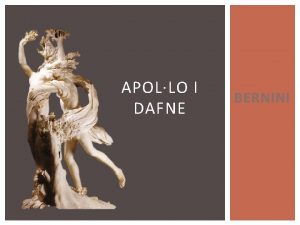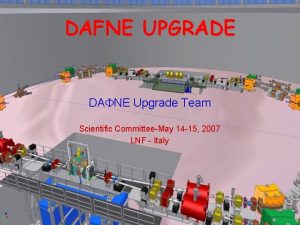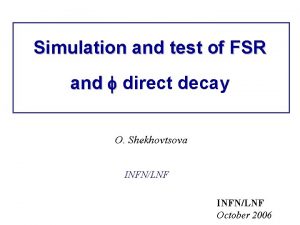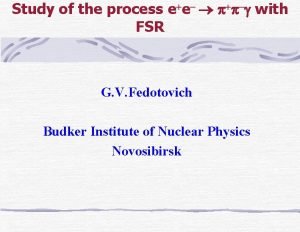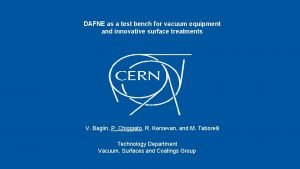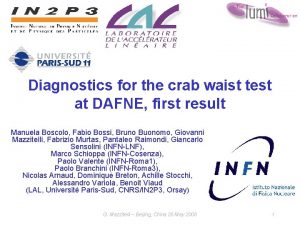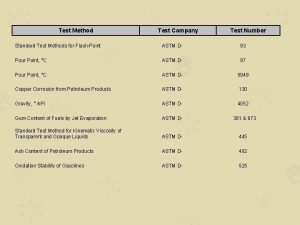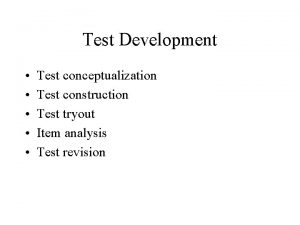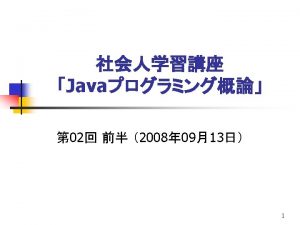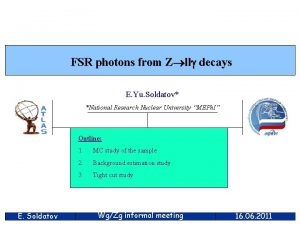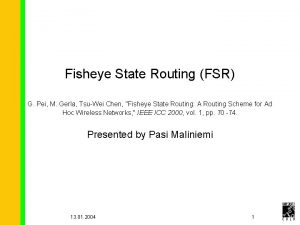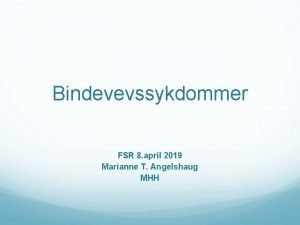Test of FSR in the process at DAFNE



















- Slides: 19

Test of FSR in the process at DAFNE G. Pancheri, O. Shekhovtsova, G. Venanzoni INFN/LNF EURIDICE Midterm Collaboration Meeting 8 -12 Feb. 2005 Frascati

FSR in s. QED (s. QED VMD) Fp(s) But how good is this approximation? s. QED VMD is reasonable for the final state. But what about g final state ? Can we use for FSR the same value of F (s) as for ? An additional contribution is model-dependent, and probably very small. But must be estimated.

Global structure of FSR tensor for P 2 = s e * • charge conjugation symmetry • photon crossing symmetry • gauge invariance and

gauge invariant tensors: scalar (model dependent) functions Limit of soft photon (what we call s. QED), in fact VMD*s. QED At threshold (very hard photon) this approximation could not work fi=fis. QED+Dfi

(S. Dubinsky et al, hep-ph/041113) FSR in Ch. PT with and a 1 mesons G. Ecker et al. , Nucl. Phys B 321, 311 (1989) The contribution with +, (instead of a 1), turns out to be negligible

4 model parameters: f , F V , GV , F A We calculate fi Meson M(Ge. V) GV (Ge. V) FA (Ge. V) r 0. 775 0. 0066 0. 156 - a 1 1. 23 - - 0. 122 in Ch. PT (S. Dubinsky et al, hep-ph/0411113) 1. pp contribution to am (analytical results) 2. Contribution to dspp /d. Q 2 pp spectrum and charge asymmetry (Monte Carlo)

pp contribution to am 10 -9 10 -8 10 -13 10 -12 Differential contribution to , where is hard ( >Ecut) am (pp) ~ 500(5) 10 -10 am (pp s. QED) 5 10 -10 Dam (pp CHPT) 0. 1 10 -10 below current experimental precision

Contribution of FSRCHPT to dspp /d. Q 2 pp spectrum and charge asymmetry The following matrix element has been introduced in a MC, for e+e- p+p- (based on EVA structure): S. Binner et al. Phys. Lett. B 459 (1999) • We neglect the contributions from g* + -g (found to be negligible in hep-ph/0411113) • We included the direct decay f + - g, important at s=mf 2. This contribution (which is model dependent) affects also the low Q 2 pp region. Charge asymmetry can help to distinguish between various models (see the talk of H. Czyz) • We consider KLOE large angle analysis: 50 o< q < 130 o, 50 o<qp< 130 o (S. Mueller talk)

We included f p+ p- decay in our calculation, by looking to the channel f p 0 p 0 (similar to H. Czyz et al. hep-ph/0412239) d. BR/dm x 108 (Me. V-1) We use the Achasov 4 quark parametrization with the parameters of the model taken from the fit of the KLOE data f p 0 p 0. (f + - g is related to f 0 0 g by isospin symmetry) CAVEAT: For the moment we consider only the contribution of f 0 (no s meson). This could be too crude for low Q 2 ! mpp(Me. V)

dspp /d. Q 2 (nb/Ge. V 2) (Analytical) Comparisons (at s=mf 2): 0 o<qp< 180 o 0 o<q < 180 o = FSRs. QED+Df = f p+ p- resonant cont. = FSRs. QED Since MFSR*Mf |Mf|2 at low Q 2 Df can be relevant only for destructive interference (we will consider only this case in the following) = Df Q 2(Ge. V 2) What happens for s<mf 2 ?

dspp /d. Q 2 (nb/Ge. V 2) The comparison at s=1 Ge. V 2 (off f peak): = FSRs. QED+Df = 100·f p+ p- resonant cont. = FSRs. QED 0 o<qp< 180 o 0 o<q < 180 o Multiplied by a factor 100 = Df 1/|Df( s)|2 Q 2(Ge. V 2) 1 Ge. V s 1. 04 Ge. V In this case the interference MFSR*Mf is expected to be >>|Mf|2 ÞWe could not neglect the interference contribution (i. e. f contr. ), but the work off the resonance region is attractive (3 p background is much less)

ds/d. Q 2 (nb/Ge. V 2) Numerical results: differential cross section… s=mf 2 50 o<qp< 130 o 50 o<q < 130 o ds. TOT/dss. QED+f/dss. QED = ISR+FSRs. QED + f ds. TOT/dss. QED+f = ISR+FSRCHPT + f Q 2(Ge. V 2) Effect al low Q 2…however the contribution of f is not much accurate (no interference with s has been taken into account)

ds/d. Q 2 (nb/Ge. V 2) A closer look at the threshold region: ds. TOT/dss. QED+f/dss. QED = ISR+FSRs. QED + f ds. TOT/dss. QED+f = ISR+FSRCHPT + f 0. 35 Q 2(Ge. V 2) Up to 30% of contribution beyond s. QED at the threshold. Results are sensitive to FSR model

And asymmetry… = ISR+FSRs. QED = ISR+FSRCHPT + f = ISR+FSRs. QED + f -25% Q 2(Ge. V 2)

Conclusions and outlook • First MC results on a generalization of FSR using Ch. PT with and a 1 mesons have been presented. • A sizeable effect can be seen on the cross section (at low Q 2 only). • The situation on the asymmetry is more complicate. Üthe result strongly depends on the parametrization of the f direct decay.

For the near future: • Improve the simulation: • better parametrization of f (including also the s meson) • study of the dependence of results on the various parameters of the models in MC • New theoretical tasks • improve the knowledge on the phi decay (in particular at low Q 2): to consider the phi decay in Ch. PT • try to take into account and ' mesons contribution in Ch. PT • Try to disentangle the various contributions: • asymmetry, and other kinematical variables (angular distributions) • Model independent analysis of fi different kinematics region? • Work off resonance

Disclaimer: all our numerical results are preliminary!!! The theoretical results is only the first step out s. QED!!!

BACKUP SLIDES

Asymmetry ISR+FSRs. QED + f ISR+FSRs. QED Q 2(Ge. V)
 Gas turbine controls
Gas turbine controls Linux fsr
Linux fsr Fsr.ac.ma
Fsr.ac.ma Soneto xiii garcilaso estructura
Soneto xiii garcilaso estructura Mujer barbuda
Mujer barbuda Tras vos un alquimista va corriendo
Tras vos un alquimista va corriendo Apolo y dafne poema
Apolo y dafne poema Apolo y dafne (bernini) caracteristicas
Apolo y dafne (bernini) caracteristicas Soneto xiii garcilaso de la vega
Soneto xiii garcilaso de la vega A dafne ya los brazos le crecían análisis
A dafne ya los brazos le crecían análisis Apolo y dafne bernini
Apolo y dafne bernini A.e. stallings, daphne (1999) meaning
A.e. stallings, daphne (1999) meaning Mūru graujamā ierīce
Mūru graujamā ierīce Tres amigas ana beatriz y carmen
Tres amigas ana beatriz y carmen Heinrich schütz dafne
Heinrich schütz dafne Hát kết hợp bộ gõ cơ thể
Hát kết hợp bộ gõ cơ thể Ng-html
Ng-html Bổ thể
Bổ thể Tỉ lệ cơ thể trẻ em
Tỉ lệ cơ thể trẻ em Gấu đi như thế nào
Gấu đi như thế nào
